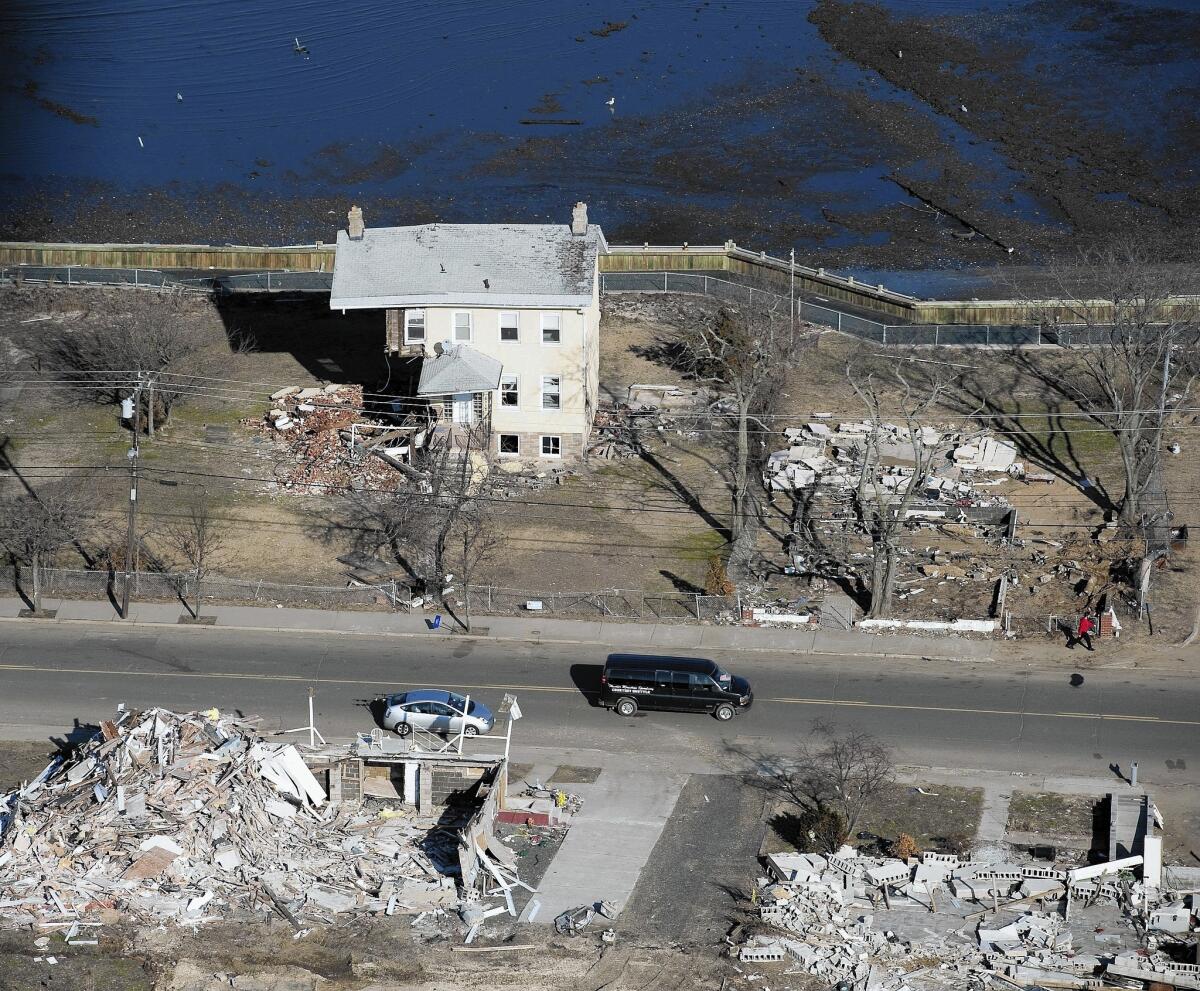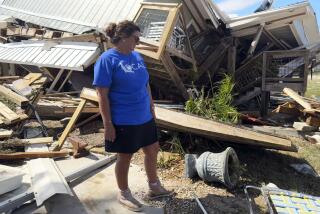Since Sandy, a storm pattern of costly stumbles in New Jersey

- Share via
Reporting from UNION BEACH, N.J. — When New Jersey officials were ready to start rebuilding after Superstorm Sandy roared up the Atlantic Coast in October 2012, they were determined not to repeat the mistakes of disasters past.
So Richard Constable III, head of the state Department of Community Affairs, flew to New Orleans to meet battle-scarred veterans of Hurricane Katrina. A $10-billion reconstruction program there called Road Home had become notorious for long delays, confusing rules and mishandled applications.
Similar complaints were widespread after Hurricane Ike walloped Texas in September 2008, the costliest storm in the state’s history, three years after Katrina.
Yet New Jersey officials ended up hiring some of the same companies that stumbled in Louisiana and Texas. Today, thousands of frustrated homeowners are still waiting for assistance, and hundreds of millions of dollars in aid are tied up in a system that no one seems able to unravel.
“There’s something very badly wrong with everything about our capability to recover from large-scale disasters,” said Dr. Irwin Redlener, director of the National Center for Disaster Preparedness at Columbia University’s Earth Institute.
“It’s just hair-raising that the same outfits that were in trouble in Louisiana continue to get work in this field,” he said.
Tens of billions of dollars are at stake. Over the last decade, the Federal Emergency Management Agency, or FEMA, has provided $120 billion for direct cleanup, aid to battered cities and grants to victims.
Congress funneled billions more directly to cities and states for longer-term assistance. The Department of Housing and Urban Development has issued $41.7 billion in disaster-related block grants since Katrina hit in 2005. That compares with $1.7 billion in the previous 13 years, HUD records show.
One result is that local and state governments frequently rely on private cleanup and consultant companies to handle the gushers of cash for them. Critics say those contractors often operate with little government oversight or accountability.
“Nobody does a particularly good job of it, and everybody keeps hiring them,” said Brad Gair, an emergency management consultant who ran Sandy recovery programs in New York City, which has also struggled with contractors and delays in delivering aid.
In New Jersey, disaster consultants were hired to do almost everything after Sandy’s waves and winds left an estimated $37 billion in damage.
They applied for the HUD block grants. They opened and staffed nine recovery centers and hired crews to rebuild homes. Consultants monitored how other consultants were performing.
Among the companies that won major contracts were Gulf of Mexico disaster veterans CDM Smith, based in Cambridge, Mass; ICF Inc. of Fairfax, Va.; and Hammerman & Gainer Inc. of New Orleans.
CDM Smith had won a $23-million contract to run a $160-million reconstruction program in Galveston, Texas, after Ike pounded the city.
But rebuilding lagged, public anger grew, and state officials brought in a new firm. Lawsuits followed, and CDM Smith contends it is still owed nearly $15 million.
Some Galveston residents were surprised when CDM Smith won a $9.5-million contract to write New Jersey’s recovery plan, said John Henneberger, co-director of the Texas Low-Income Housing Information Service, an advocacy group.
“Everybody here was saying: ‘What the hell? Didn’t anybody tell them?’” Henneberger said.
In a statement, CDM Smith said it had built a “compassionate disaster recovery program” in Galveston that processed more than 2,000 applications “while meeting ever-changing city and state directives.”
ICF played a major role in Louisiana after Katrina. The company won a key Road Home contract in 2006 and ultimately was paid about $900 million.
But delays hampered the program, and the state assessed a $1-million performance penalty in 2008. The state did not extend the ICF contract in 2009.
Steven Anderson, an ICF spokesman, said the company worked “under enormous time pressure” to distribute $8 billion to 100,000 people. “We consider that a success story,” he said. He said ICF vigorously disputes Louisiana’s claims about mistakes in evaluating cases.
Hammerman & Gainer, or HGI, took over Road Home after ICF. Despite improvements, storm victims still complained about long waits for checks. Louisiana assessed HGI $556,500 in penalties from 2009 to 2013, mostly for delays in handling applications, state records show.
Last year, HGI won a $68-million contract to administer New Jersey’s largest housing recovery programs, including one that set aside $710 million to help rebuild storm-wrecked homes.
In its proposal, HGI said its team was “battle-hardened” from its work in the gulf and could “leverage invaluable lessons learned from prior long-term recovery engagements.”
But New Jersey officials soon accused HGI of failing to develop a computer software system that could handle homeowner applications.
“While HGI touted its ‘expertise’ in previous disaster recovery efforts … this ‘expertise’ had not led to even adequate performance,” Howard McCoach, a state contract manager, wrote in an 11-page letter to HGI in March of this year.
McCoach wrote that “missing files, illegible files and mismatched files” made it difficult to process applications or track their progress. State officials “could not trust the developers or the data,” he wrote.
In September, the letter said, New Jersey community affairs officials decided they could not trust HGI’s decisions on whether to grant benefits, and state workers began reviewing cases themselves.
Ultimately, nearly 80% of people denied benefits by HGI won their appeals and were given grants, according to the Fair Share Housing Center, a housing advocacy group.
HGI, in turn, blamed New Jersey officials for causing confusion and delays, state records show. HGI complained that the state kept changing program rules, redesigning the website and issuing conflicting orders.
New Jersey and HGI agreed to terminate the contract in December. The state paid $36 million to the company, state records show, and another $21 million is in arbitration.
HGI declined to comment for this article.
When HGI left, Constable’s department gave ICF — the original Road Home consultant in Louisiana — a $36-million contract to help run the reconstruction and rehabilitation program. ICF already was an advisor to state officials.
Paperwork problems have eased since then, officials say, and 2,700 people have signed agreements to receive grants. But some homeowners still complain about long delays. ICF has been paid $11.1 million so far.
Anderson, the ICF spokesman, referred questions about the company’s performance to New Jersey officials, who did not respond to requests for comment.
Gov. Chris Christie was asked about HGI during a Feb. 20 town hall meeting in Port Monmouth, which was devastated by Sandy. He said hiring contractors was better than adding more state employees.
“If what you’re hoping for is that every decision that’s made regarding billions of dollars is going to be made perfectly the first time, then you know, your expectations are not where they need to be,” Christie said.
On June 16, on his radio call-in show, Christie acknowledged the recovery problems but pointed to progress. “Businesses are coming back, homes are coming back,” he said.
In Union Beach, the storm damaged or destroyed nearly half the 2,100 homes in the beachfront town of small bungalows and corner taverns.
Despite new construction, the town is still raw with scars. One recent day, cranes put modular homes on platforms as pickups and utility trucks crowded muddy streets. With street signs gone, addresses are painted on plywood sheets. Some homes are abandoned, or in foreclosure.
Miguel Aponte, a 39-year-old welder, said Sandy left his house a total ruin. In January, he was approved for the maximum state reconstruction grant, $150,000. He didn’t get his first check until last month, however, and work has stopped while he waits for the rest.
“Apparently every other week they kept losing our paperwork,” Aponte said. He, his wife and their three children live in a trailer in their yard.
“We did everything by the book and still got screwed — that’s what hurts,” he said.
Constable, the state official who flew to New Orleans after Sandy, declined to be interviewed. He told state legislators in April that he had heard about contractor problems on the gulf, but said it was “not uncommon” for the handful that specialize in disaster work. He blamed some delays on complicated HUD rules.
“Unfortunately there is no playbook for recovery from a storm like Sandy,” he said. “This state has never done anything like this before.”
More to Read
Sign up for Essential California
The most important California stories and recommendations in your inbox every morning.
You may occasionally receive promotional content from the Los Angeles Times.









